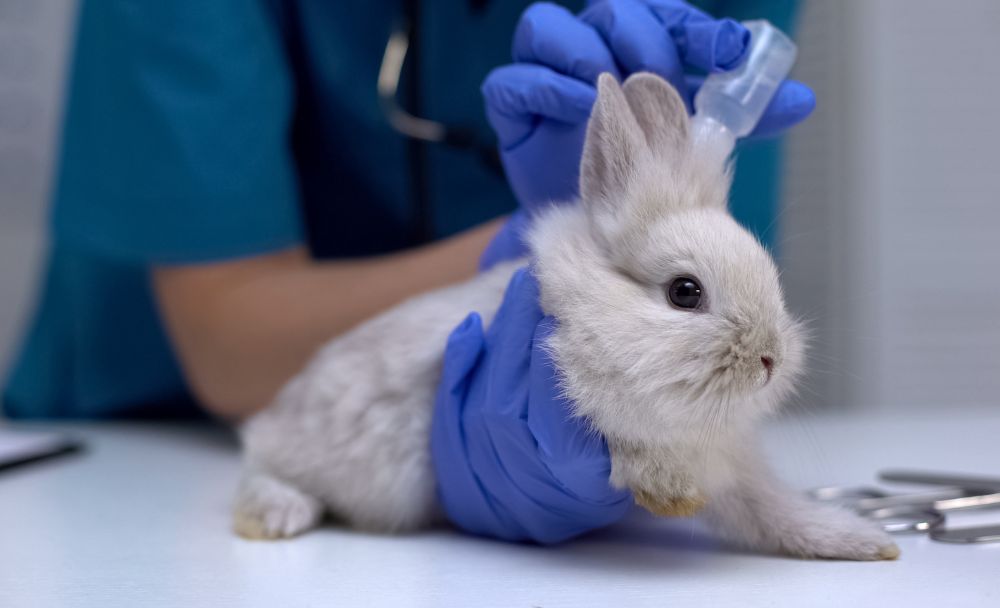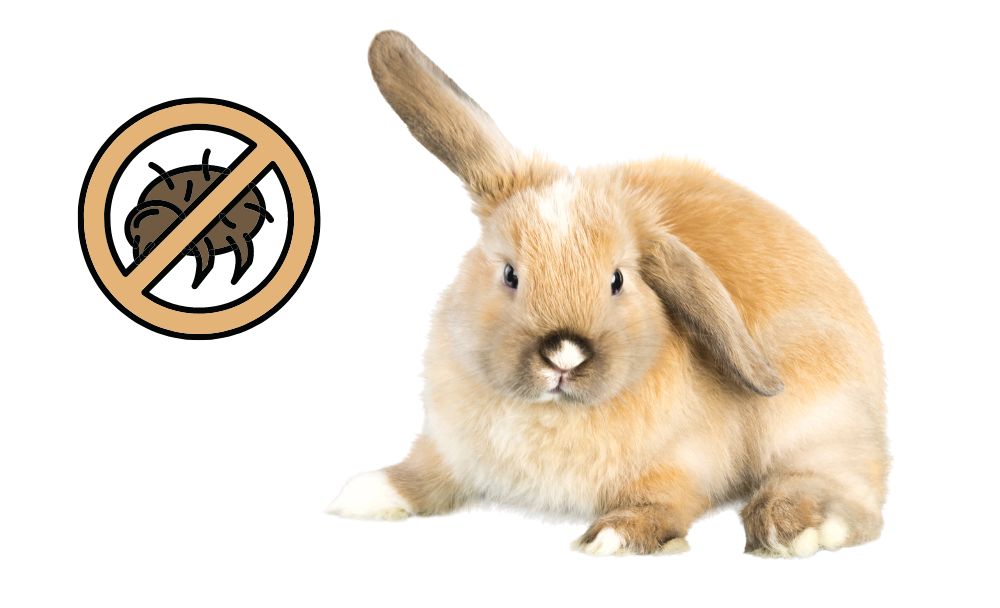Ever struggled with a rabbit that scratches their ears till the fur flies? Rabbit ear mites are a painful and thoroughly irritating cause of itching ears and ear canker (a highly contagious disease).
Learn all about the what, why, and how of rabbit ear mites to protect, treat, and heal your rabbit’s itchy ears and keep your bunny in optimal health.
What Are Rabbit Ear Mites?
Rabbit ear mites are just one of several types of mites that rabbits can become infested with. The Psoroptes cuniculi species of mite are drawn to the rabbit’s ears, and these blood-sucking parasites feast on the thinner skinned areas of the inner ear. Ear canker can result and even prove fatal.
While mites are small (the size of a pinhead), you can see them scurrying about with the naked eye if you look inside the ear and on the flaps of the pinna or ear flap.
Life Cycle of Ear Mites
In a mere 21 days, the Psoroptes cuniculi ear mites will hatch from eggs as six-legged larvae. These larvae molt after four days for a three to ten day cycle before becoming protonymphs with eight legs. Throughout this cycle, the larvae and protonymphs will feed on blood meals.
With some additional molting, the protonymphs will mature into adults that can breed, lay eggs, and continue feeding before eventually dying. Should the mites fall off the host, the mites (regardless of their life stage) can live anywhere from four to 21 days as long as the environmental conditions are ideal.
Larvae may fall off with a chunk of dead skin and waxy inner ear cells that they continue to feed on while they mature and look for another host. The mature protonymphs have no problem finding a new host as they are more mobile with their eight legs.
What Causes Ear Mites in Rabbits?
Ear mites are usually present in the rabbit’s environment, and the spread is quite contagious as these mites reproduce exponentially. The health and environment of the rabbit’s ears may attract more ear mites if the conditions are ideal for breeding—cool and damp.
Psst: This is why you should never get water into your rabbit’s ears as moistening this environment is like calling on the local mites for a feast.
How Do I Know If My Rabbit Has Ear Mites?

The first sign will be excessive scratching at their ears, which indicates your rabbit isn’t happy with the itchy feeling inside their ears. Soon, scabs will begin to form as the mites feast on the skin of the inner ear. The skin then oozes a clear liquid that solidifies and forms ear canker when the perforated skin of the ears become infected.
Ear canker (or contaminated liquid and skin cells) is highly contagious, causing secondary bacterial infections. It can even cause fatal meningitis.
Signs of Early Stage Rabbit Ear Mites
If your rabbit shakes their head, scratches, or rubs their ears more frequently than usual, they may have an ear mite infection starting.
Limp and hanging ears (or not wanting their ears touched when they are usually tame and enjoy touch with lop eared rabbits) may indicate there is already a more advanced problem deeper inside the ear, and you should consult your vet.
Likewise, heads carried at a slant also indicate mild ear mites in rabbits.
Redness on the pinnae of the ears may also indicate irritation caused by ear mites that are setting up shop. In advanced cases, the scabs can spread to other parts of the body such as between the rabbit’s toes, around their neck and lower jaw, and under their armpits.
When grooming your rabbit, look for any irritation, missing fur, scabs etc.
Pictures often show lop eared rabbits with severe dermatitis or scabs in their ears from ear mites as lop eared rabbits are highly susceptible to it.
Do Ear Mites Hurt Rabbits?
While the actual bite of an ear mite may not even register on a rabbit, the results of being fed on by many ear mites will be painful to your rabbit. When the mites bite the ear tissue, clear fluid oozes out, becoming septic, forming scabs that itch terribly, and soon these scabs will bleed as the rabbit tries to scratch the itching areas.
The bloody, scabby mess can lead to self-harming by excessive scratching and the resulting injuries are VERY painful and distressing for a rabbit.
Rabbit Ear Mite Treatment

Treating ear mites is a comprehensive process. Your vet will recommend oral and injectable medications like avermectin drugs such as ivermectin and selamectin. These are usually administered in injectable form by your rabbit veterinarian, with follow-up injections or oral doses as the mites need to be killed at different life stages. Newly hatched eggs will need follow-up doses to completely kill the infestation.
Consult with your vet about combining anti-inflammatory drugs and antibiotics if the infection is severe. Pain medication such as Ibuprofen suspension at 15 mg per 2.2 pounds of body mass can help alleviate pain and boost healing.
How to Treat Rabbit Ear Mites at Home
Treating a rabbit with ear mites requires that the rabbit be visually examined to establish the severity of the infestation of mites. If the presence of mites is still minimal, topical application of mite treatments such as ivermectin drops as prescribed by your veterinarian.
Home remedies such as olive or coconut oil are reported as being helpful by smothering the mites, though it can also lead to inner ear damage if used in excess. Avoid common over-the-counter mite treatments that will be toxic to rabbits.
Ensure you clean and disinfect the rabbit’s hutch, run, and any toys while you treat the infestation. Replace all bedding material as it’s difficult to clean soft material where the mites can hide. If the infestation of mites is severe, you may need to replace the whole rabbit enclosure or move the rabbit cages away to a new area for at least three to six weeks.
While cleaning the rabbit enclosure, keep your rabbit away as the fumes from most disinfectants is toxic to a rabbit’s delicate respiratory system. Steam cleaning the area is safer and the high heat will kill the mites and their eggs.
Can Scarlet Oil Help Rabbit Ear Mites?
While you may be tempted to disinfect the pinnae of the rabbit’s ears when you notice the redness, swelling, and scabbiness of an ear tick infestation, you should exercise caution. Scarlex® Scarlet Oil Spray Wound Dressing is a popular antiseptic dressing for wounds, but it is not appropriate to apply it liberally to the scabs or infestation site of the rabbit’s ears.
Instead, you may dab some scarlet oil to any deep scratches that result from the rabbit’s constant scratching with their hindlegs. Take care not to drop scarlet oil into the ear canal as it can burn your rabbit.
Rabbit Ear Mite Removal
Removing ear mites isn’t viable due to the small size of the mites and eggs. Instead, treatment is the only option. At no point should the scabs that form on the rabbit’s pinnae be removed without first sedating the rabbit as this procedure is very painful and can lead to shock and death.
Can Humans Get Ear Mites from Rabbits?

Rabbit ear mites aren’t usually transmittable to humans; however, cases of infection have been recorded. If your rabbit has ear mites and ear canker, it is important to watch for similar symptoms in yourself. Should your ears begin to itch, ring, or feel burning, you may need to consult with your medical healthcare practitioner.
Can I Use Ivermectin for Rabbit Ear Mites?
You can use ivermectin injectables and ivermectin topical solutions to help kill off the parasitic infestation of ear mites in your rabbit. However, this treatment course should be carefully recommended by your vet as the dosage is important.
Each rabbit weighs differently, and the vet will be able to calculate the dosage based on the severity of the ear mite infestation and the rabbit’s weight and general health. The vet will also prescribe appropriate intervals for repeat treatment (which is important to the successful treatment).
Can Rabbit Ear Mites Spread to Dogs?
Dogs and other rabbits can easily catch ear mite infections from an affected rabbit. If you bring a new rabbit into your home, it is important to have them fully checked by your vet and keep them in isolation while you observe any scratching behavior they may exhibit.
Also keep infected rabbits away from your other pets and children. When transporting the rabbit, use a rabbit carrier cage and avoid close contact as the mites can hop onto your clothes and then transfer to your dogs once you get home.
Can Rabbit Ear Mites Transfer to Cats?
While cats usually contract ear infections from a different species of ear mite than the mites that cause ear canker in rabbits, your cat can still become very sick when ear mites transfer from your rabbit to them. Cats tend to develop itchy spots all over their body from transferred mites, which will lead to painful scratching and localized inflammation.
Protecting Your Rabbit from Ear Mites in the Future

The best protection for your rabbit is prevention. By keeping your rabbit away from other animals that may have ear mites, such as wild rabbits, ferrets, and other domesticated pets, your rabbit has a good chance of never contracting the condition.
Regularly check your rabbit for injuries, raw ears, scratch marks around their ears, lopsided head carriage, and irritation. The sooner you can catch an ear mite infection, the better and easier it will be to treat.
Regularly take your pet rabbit for vet checkups, and when you do, place your rabbit on a special towel you use for these trips only (washing it in hot water as soon as you get home) to prevent your rabbit catching any eggs, larvae, or mites from any pets that were at the vet before them.

